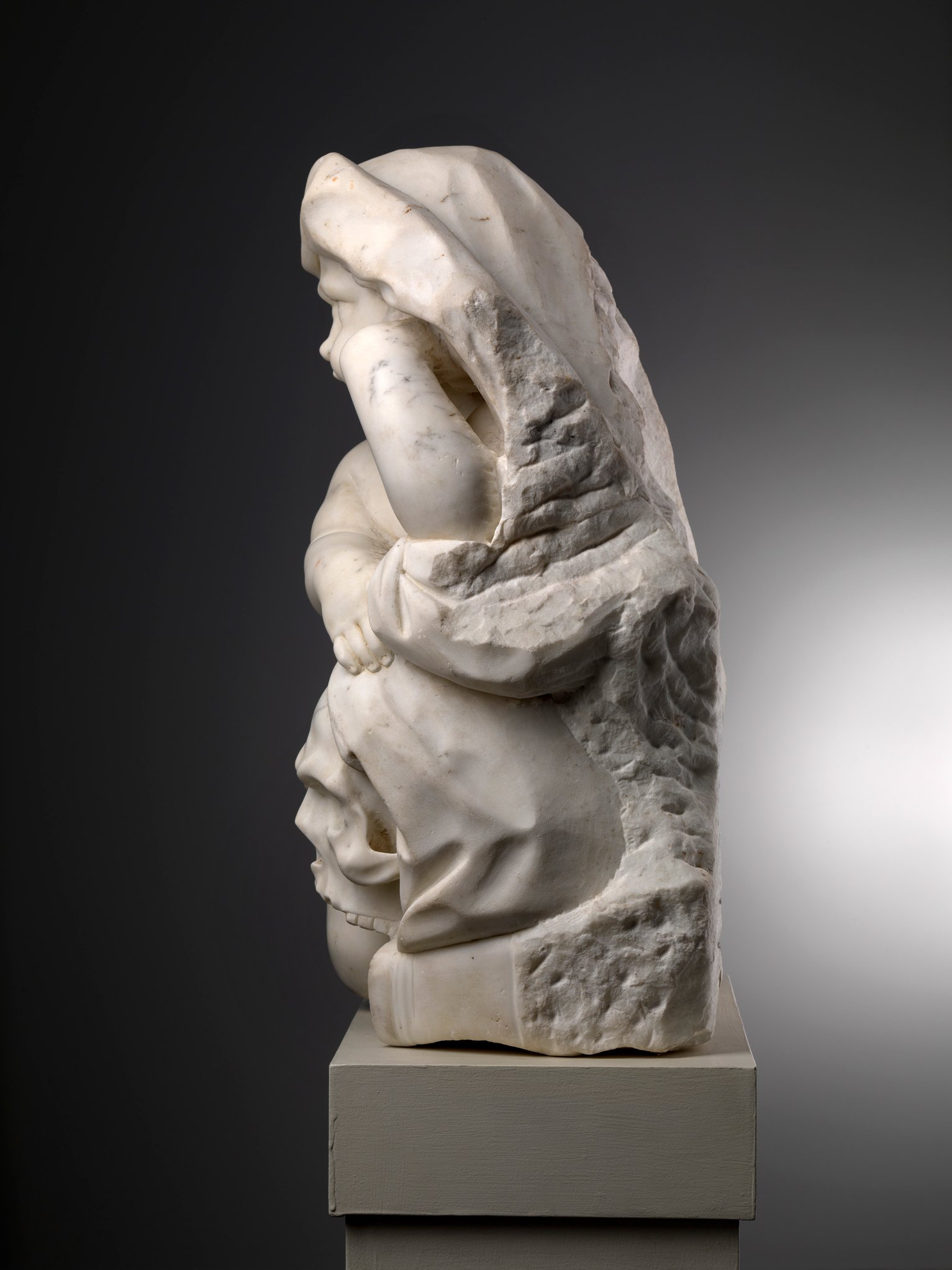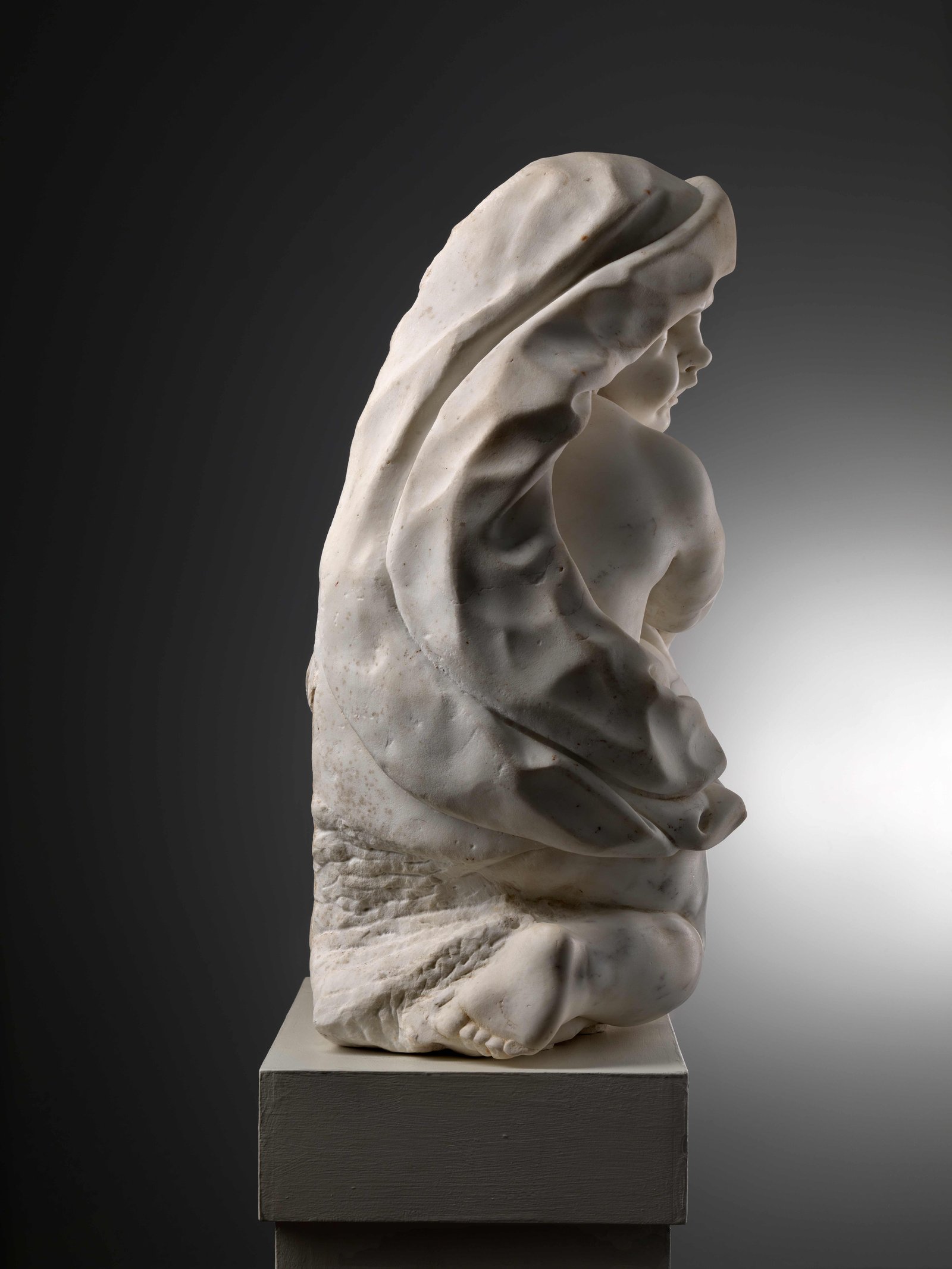Giovanni Comin’s Putto with a Skull and a Book
An analysis of a 17th century Venetian Baroque sculpture by Giovanni Comin, which meditates on death and defeats the call to worldly goods
This inedited kneeling putto has its face directed towards the onlooker. Indeed, he shows us his weeping, which must be read as the most primordial answers to the discovery of the inevitability of the common human destiny, that is its material transience [1]. A painful feeling that has in the presence of the skull – on which our child rests his right hand and which he holds to himself by means of the mantle that partly dresses him – his primary cause. The skull, which is without the mandible and the incisors and canines of the upper dental arch, is placed over a closed volume. The dense shadows arising from its concave eye sockets and deeply hollowed nostrils are aligned almost vertically to the putto’s face, but opposing it for the play of solids and voids. The putto is in fact characterized by a hyper-expressive facial expression with a strong prominence chiaroscuro. In short, we are faced with the lively reaction of one on the silent and perennial impassivity of the other.

The work is carved in a single block of Carrara marble and is presented on the left side, entirely covered by the rough marks of the pointed chisel and the mallet, both tools used by the artist for the first roughing. The back also offers some similar tracks; in the center the wall of the marble is substantially smooth, with, however, the presence of an evident difference in height in the middle. All these data lead us to believe that originally the sculpture should have been hooked and leaning against a more complex structure – since the right side is more refined than the other, it was evidently the one visible to the observer.
Putto with the Skull and the Book recalls, as already mentioned, the theme of Vanity, that was one of the concepts most dear to Seventeenth-century European culture. [2] This particular subject had in that century one of its moments of greatest ‘fortune’ and ‘success’, coming to have a real iconographic development not comparable to that of previous periods, including the Sixteenth Century. With its representation an attempt was made to “overcome the trauma of mortality” by becoming aware of oneself and one’s own finitude. If on the one hand it was necessary “to meditate on death, to defeat the call to worldly goods, being the earthly things ‘paintings of clouds appearing disappeared, flours mixed with privations, lies colored with probable spirits volatile in being, not fixed in lasting, shadows'” [3], on the other hand, vanitas – with the implicit reference to the biblical: “Vanitas vanitatum et omnia vanitas” – led man to excessively exasperate the essence of the meaning of Horatian carpe diem, of that “Quant’è bella giovinezza, che si fugge tuttavia! Chi vuol esser lieto, sia: di doman non c’è certezza” sung by Lorenzo the Magnificent in his Il trionfo di Bacco e Arianna of 1490. Seize the moment, therefore. Give space to the senses, in search of pleasure and enjoyment, to the immediate satisfaction of desire, carnal or intellectual as it was.

As always happens with sculptures depicting subjects of this type, whose generic nature implies a strenuous recourse to micro-philology, the only possibility for a serious attributive solution is to identify within the catalog of a particular author one or more works that have incontrovertible and strikingly identical entanglements with the one examined. In this case, what is surprising is precisely the superimposition of the face of the Putto discussed here with the child present in the Ballarin Chapel of the church of San Pietro Martire in Murano, a statue made, together with the others preserved there, by the Treviso sculptor Giovanni Comin (1647 ca – 1695) [4]. We are around 1681 and Comin, in addition to the statues of the altar, also sculpted two funeral memories, including the one dedicated to Giovanni Battista Ballarin where, to the right of the bust of the deceased, stands the Putto with the aforementioned skull. Differently from ours, this one is standing and holding with his right hand (the other arm is totally missing) the skull, which, like the one in the work examined, is devoid of both the jaw and the upper teeth. The faces, both caught in a sad cry, have the same physiognomic features, even if the Putto examined here denotes a higher quality, also supported by its excellent state of conservation.

Other useful comparisons to certify the paternity in Comin can be found with the various angels that adorn the altar of the Madonna di Rimini in the church of San Marziale in Venice. [5] Here the complexion of the plump and smooth bodies is similar and also the modulation of the drapery, characterized by a resentful, thick volume and whose surface is crossed by clear dents. Furthermore, a detail that could already be seen in the putto from Murano, even in these figures the author employed the use of the drill to mark the thick curls of the hair in the center. A detail that also returns in the group of angelic figures – in the past, part of a tabernacle unfortunately dismembered – today visible on the table of the Zen-Valier altar (Venice, Basilica of Santa Maria Assunta dei Frari). [6]
Born around 1647 in the main city of the Treviso area, Giovanni Comin, according to the documentation found so far, must have arrived in Venice around 1677; he was therefore an artist already trained. The following year he attended as godfather the baptism of Olivia Agnese, daughter of the carver his fellow countryman Giacomo Piazzetta. [7] A testimony that somehow associates him with the group of artists closest to the champion of Baroque sculpture of the Serenissima, Giusto Le Court, who however died shortly thereafter, in the autumn of 1679. To September of that same year dates back to testimony of Parenti, Este ambassador in the lagoon, who, writing to the Duke of Modena Francesco II, mentioned among the other famous sculptors present in the city also “Giovanni Comini known as Trivisano”. The artist had therefore by now reached a certain notoriety, so much so that he was approached by masters of the caliber of Le Court, Ongaro, Marinali and Tommaso Rues. Proof of his acquired position in the Venetian artistic panorama was certainly his participation in the decoration of the new altars of the basilica of Santa Giustina in Padua, where in fact he created, between 1680 and 1681, the Rachele piangente and two groups of putti for the altar of the Innocents; another set of putti and the main statue for the altar of San Giuliano; and, finally, the San Filippo Apostolo for the altar dedicated to San Massimo. [8] Still in the antenorean city, but this time for the Saint, he made the sculptures for the Monumento funebre a Pietro, Domenico e Antonio Marchetti, a work completed in 1690. [9]

Respect than the Putto with skull of Le Court in the Cavazza Monument to the Madonna dell’Orto, rightly referred to as the prototype of the statue in San Pietro Martire in Murano, it seems more plausible that Comin for the marble examined here was inspired by those made by the Bolognese Clemente Molli around 1659 for the facade of the church of the Abbey of Misericordia in Venice. It is known that Giovanni painted an image depicting San Domenico for the chapel of Santa Filomena, in that same church.
It is therefore conceivable that, as both the Monumento Ballarin in Murano and Mercy reserved for Gasparo Moro testify, our Putto was originally part of a much more complex group. In this regard, it must be remembered that Comin was employed from 1694, together with many other artists, to the realization of the plastic decoration for the deposit – which in Antonio Gaspari’s projects consisted of two large pyramid structures placed one in front of the other – of Doge Francesco Morosini. Although the project was never completed, we know that some of the sculptures were actually made. [10] But of their subsequent affair nothing has emerged and nothing, unfortunately, we continue to know.
[1] Humana fragilitas, 2000 is a good viaticum to the understanding of this subject.
[2] See Scaramella, 2000
[3] Ibid., p. 75.
[4] The bibliography on Giovanni Comin is limitate. It’s possible to refer to Semenzato 1966, pp.26-27, 90 91, and to Susanna Zanuso’s text in Da Sansovino 2000, pp. 724-725. Other contributions, but of a purely attributionary nature, are Guerriero 2009, p. 206; Tulić 2009 (for the recognize of sculptures of Cappella Ballarin in Murano); Sava 2015, passim; Tulić 2016; Favilla ans Rugolo 2016, passim.
[5] For this complex see Guerriero 2009, p. 206.
[6] Cfr. Tulić 2016, p. 44.
[7] Favilla and Rugolo 2016, p. 82 note 33.
[8] See the recent De Vincenti and Guerriero 2020, passim.
[9] For this work see De Vincenti and Guerriero 2021, pp. 1452-1455
[10] Favilla and Rugolo 2004-2005, pp. 113-118
Bibliography
Semenzato 1966:
C. Semenzato, La scultura veneta del Seicento e del Settecento, Venice 1966.
Sansovino 2000:
Da Sansovino a Canova, repertorio fotografico a cura di A. Bacchi, Milan 2000.
Humana fragilitas 2000:
Humana fragilitas. I temi della morte in Europa tra Duecento e Settecento, curated by A. Tenenti, Clusone (BG) 2000.
Scaramella 2000:
P. Scaramella, L’Italia dei Trionfi e dei Contrasti, in Humana fragilitas. I temi della morte in Europa tra Duecento e Settecento, curated by A. Tenenti, Clusone (BG) 2000, pp. 25-98.
Favilla and Rugolo 2004-2005:
M. Faville and R. Rugolo, Frammenti della Venezia Barocca, “Atti dell’Istituto Veneto di Scienze, Lettere e Arti”, 163, 2004-2005, pp. 47-138.
Guerriero 2009:
S. Guerriero, Per un repertorio della scultura veneta del Sei e Settecento. I, “Saggi e memorie di storia dell’arte”, 33, 2009, pp. 205-292.
Tulić 2009:
D. Tulić, Per Giovanni Comin. L’arredo marmoreo secentesco della cappella Ballarin a Murano, “Arte|Documento”, 25, 2009, pp. 165-171.
Sava 2015:
G. Sava, Scultori veneziani del Sei e Settecento a Brescia e a Bergamo: Giovanni Comin, Pietro Baratta, Antonio Gai, “Arte Veneta”, 72, 2015, pp. 202-210.
Favilla e Rugolo 2016:
M. Favilla and R. Rugolo, Le “deliranti fantasie” barocche di Giovanni Comin, Enrico Merengo, Antonio Molinari, Giacomo Piazzetta e Domenico Rossi, “Saggi e memorie di storia dell’arte”, 40, 2016, pp. 79- 107.
Tulić 2016:
D. , Kipovi Giovannija Comina na glavnom oltaru franjevačke crkve na Trsatu, “Radovi Instituta za povijest umjetnosti”, 40, 2016, pp. 35-49.
De Vincenti and Guerriero 2020:
M. De Vincenti and S. Guerriero, Le sculture e gli altari barocchi di Santa Giustina, in Magnificenza monastica a gloria di Dio, curated by G. Baldissin Molli e F. G.B. Trolese, Roma 2020, pp. 379-403.
De Vincenti and Guerriero 2021:
M. De Vincenti and S. Guerriero, Monumenti sepolcrali del Seicento, in La Pontificia Basilica di Sant’Antonio in Padova, curated by L. Bertazzo e G. Zampieri, vol. II, Roma 2021, pp. 1397-1458.
August 30, 2023
